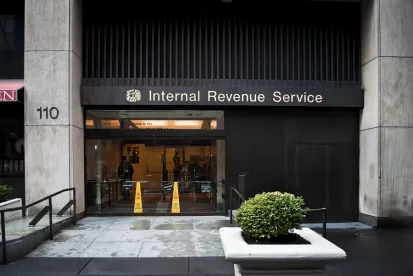One of the more controversial and complex provisions of the Tax Cuts and Jobs Act has been the 21 percent excise tax on certain nonprofit executive compensation. On December 31, 2018, the IRS issued interim guidance that addresses how this tax will apply in various situations that commonly arise for tax-exempt employers. Establishing internal systems to comply with this guidance will be challenging.
IN DEPTH
One of the more controversial and complex provisions of the Tax Cuts and Jobs Act has been the 21 percent excise tax on certain nonprofit executive compensation. Section 4960 of the Internal Revenue Code imposes this tax on remuneration over $1 million and excess parachute payments that are paid by tax-exempt employers with respect to covered employees for tax years beginning after December 31, 2017. Covered employees for this purpose includes an employee or former employee who is “one of the five highest compensated employees of the organization.”
On December 31, 2018, the IRS issued interim guidance that addresses how this tax will apply in various situations that commonly arise for tax-exempt employers. Overall, the IRS has interpreted Section 4960 in a manner that is unfavorable to tax-exempt employers, particularly nonprofit health systems. Establishing internal systems to determine which employees are covered by this excise tax is likely to be challenging. Key highlights of Notice 2019-09 include:
-
Multiple employers within a tax-exempt system can each be separately subject to the excise tax. The phrase “high five employees” is now officially misleading. Each tax-exempt employer must separately determine which of its employees are “covered employees” rather than focusing only on the five highest-paid employees across the entire system, as is the case with publicly held corporations subject to Section 162(m). The IRS has rejected the position that a group of related tax-exempt employers should only need to identify its five highest-compensated employees systemwide. This is one of the most controversial provisions of the Notice. As result, complex tax-exempt systems could potentially have several entities with dozens of employees earning compensation that triggers the excise tax.
-
Employees earning significantly less than $1 million can be covered employees and covered employee status never ends. There is no minimum dollar threshold for an employee to be a covered employee. Even if a tax-exempt employer has no liability under Section 4960 for one year with respect to a covered employee, it may become subject to an excise tax for that covered employee in a later year. The IRS has confirmed that once an individual is a covered employee by being among the highest five paid employees, he or she retains that status indefinitely even as compensation and services may vary over time. As a result, each tax-exempt employer within a system must identify its covered employees annually and keep a log of covered employees indefinitely.
-
The determination of who is a covered employee is complicated. Who is a covered employee with respect to a tax-exempt employer is determined based on remuneration paid by that employer as well as remuneration for services performed as an employee of a related organization. The Notice generally defines a related organization to include any entity, whether or not tax-exempt, using a more-than-50 percent control test. As a result, each tax-exempt employer within a system must determine the extent to which remuneration must be imputed to its employees from related organizations in determining covered employee status. Further complicating matters is that an individual can also be deemed to be an employee of more than one tax-exempt employer. Indeed, it is possible that a single employee could be a covered employee with respect to more than one tax-exempt employer within a system.
-
The “medical services” exclusion is very narrowly defined. Section 4960 provides that compensation paid to a licensed medical professional for medical services is not compensation for purposes of determining covered employees or amounts subject to the excise tax. The interim guidance adopts a narrow read and excludes only compensation paid for the “direct performance” of medical services to patients, not compensation for teaching, research, or administration. This interpretation raises logistical challenges for hospitals and health systems. If a Chief Medical Officer’s employment agreement does not expressly allocate the portion of compensation paid for direct medical services versus all other services, the employer must make a reasonable, good faith allocation using billing records (for patients, insurance, Medicare/Medicaid), timesheets, comparable salaries for the non-medical duties performed, or other reasonable bases.
-
Multiple entities within a tax-exempt system may be liable for a portion of the excise tax. Determining which entities within a tax-exempt system are liable for the excise tax is also likely to be a complicated exercise. The Notice includes rules for allocating the excise tax among a tax-exempt employer and related organizations. In fact, a tax-exempt employer may have liability under Section 4960 directly for its covered employees and additionally as a related organization, subject to limited relief to avoid double counting compensation payable to the same employee.
-
The excise tax can apply to governmental entities. The 21 percent excise tax applies to governmental entities exempt from tax under Section 115 of the Code, as well as other governmental entities that have applied and received recognition of tax-exempt status as Section 501(c)(3) organizations (“dual-qualified” organizations). Only governmental entities that fit neither of these categories can avoid the excise tax (e.g., a state college with no IRS determination letter). For example, if a state university recognized under Section 501(c)(3) pays its covered employee head football coach $5 million per year, it would face an $840,000 excise tax (21 percent of $4 million) during each year of the contract.
-
The excise tax is determined based on the calendar year. In order to reduce complexities associated with multi-corporate tax-exempt systems having entities with different tax years, the Notice clarifies that the excise tax is determined on a calendar year basis, not based on the taxable year of the employer. This is an important development for non-fiscal year employers, as it should reduce the administrative burden that might otherwise arise if these employers were required to allocate compensation paid during a single calendar year to multiple fiscal years.
-
Compensation vesting in the employer’s taxable year beginning after 2017 (or in any later calendar year) is considered paid when vested. Compensation generally counts toward the $1 million threshold when it vests, rather than when it is paid. Amounts that accrued and vested prior to the employer’s taxable year beginning in 2018 do not count toward the threshold; this is the only grandfathering exception under the Notice.
-
Payments made upon separation from service that are less than $1 million can be subject to the excise tax. As noted above, “excess parachute payments” paid to covered employees are subject to the 21 percent excise tax, irrespective of whether those payments are more than $1 million. While based on golden parachute concepts applicable to for-profit companies, the Notice takes an expansive view as to what is an excess parachute payment under Section 4960. Subject to only a few exceptions, most types of compensation triggered by an involuntary separation can potentially be parachute payments, including payments made contingent upon complying with a non-compete and accelerated vesting of benefits even if no actual payment is made. An involuntary separation from service for this purpose generally includes an employee’s termination of employment without cause, an employee’s failure to renew a contract and bona fide good reason employment termination by an employee. There are also special provisions broadly defining separation from service (as compared to Section 409A) to include certain changes to the service relationship, even if an employee is still employed by a tax-exempt employer. As expected, the total payments in the nature of compensation that are contingent upon an involuntary separation from service will only be parachute payments if they are three or more times the employee’s base amount (which is a measure of historic taxable compensation as determined under Section 280G). Excess parachute payments equal the portion of the parachute payments that exceed the base amount.
-
A “good faith, reasonable interpretation” of Section 4960 is sufficient until future guidance is issued. Where open questions remain, tax-exempts must adopt consistent and reasonable approaches to comply with Section 4960 based on all of the facts and circumstances.
The Notice raises many issues for tax-exempt employers. We are continuing to evaluate the Notice and will be sharing additional thoughts going forward to help general counsel and executive compensation committees evaluate the impact of this development.






 />i
/>i
